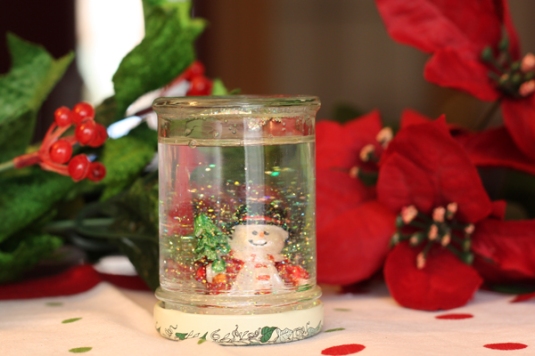I love the idea of giving friends and family something a little more personal and heartfelt for Christmas in addition to store-bought gifts from their wish list. It’s easy to reuse fancy jars, glitter and Christmas ornaments laying around the house for a quick and easy homemade Christmas present or stocking stuffer!
Snowglobe
Materials: Small reused jar, old Christmas ornament, glitter, baby oil and super glue.
1. Find a small jar and fill it up with baby oil, which will make the glitter fall slower. Fill the jar to the brim as much as you can.
2. Add a teaspoon of glitter.
3. Find a small Christmas ornament, remove the rope that is used to hang it on the tree, and add super glue to the bottom of the figurine. Hold it steady on the jar cap for at least a minute, and then let it sit on the super glue for a few more minutes. Once the super glue is dry and the figurine is stuck securely to the cap, flip it upside down and screw it to the jar.
Cookie In A Jar
Who doesn’t love cookies?
Materials: reused jar, ribbon, Christmas card and dry ingredients from a cookie recipe.
1. Use our peanut butter chocolate chip cookie recipe for this one! Layer the dry ingredients in a clear jar.
2. Write out the recipe on a Christmas card, noting that all they have to do is mix together any wet ingredients in a bowl, and then dump the contents of the jar and mix.
3. Attach the recipe to the jar with a ribbon.
Lemon ‘cake’ sugar scrub
This smells like lemon cake. Need I say more?
Materials: One cup sugar, half cup vegetable glycerin, one tablespoon grated lemon zest, a small reused jar, Christmas card and ribbon or bow.
1. Mix one cup sugar, half a cup vegetable glycerin and one tablespoon grated lemon zest in a small bowl until mixture is smooth.
2. Pour into a small jar and attach a small Christmas card and ribbon or bow. Don’t have vegetable glycerin? Use olive oil. Leave a note attached to the jar cautioning the recipient to wipe off the bathtub floor as oils are slippery.
– Silvia
This is an excerpt from an article I wrote for The Reflector. Check out the full article here.










